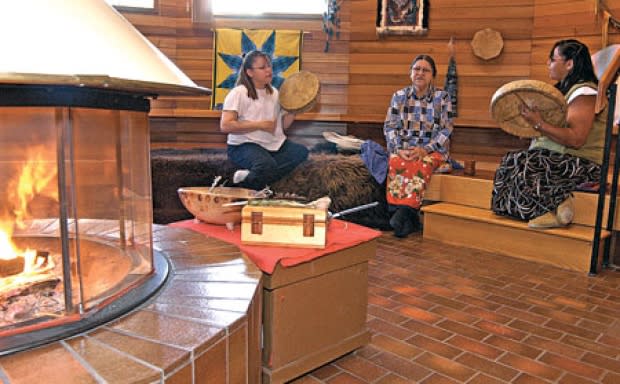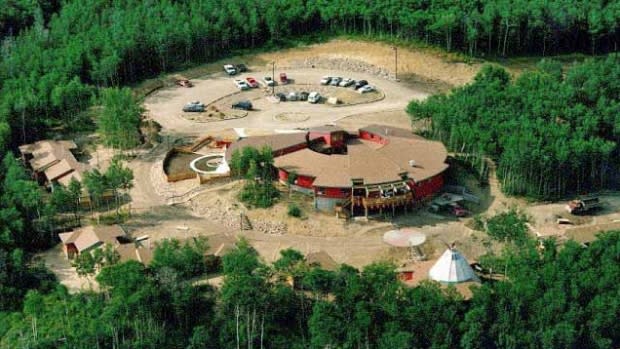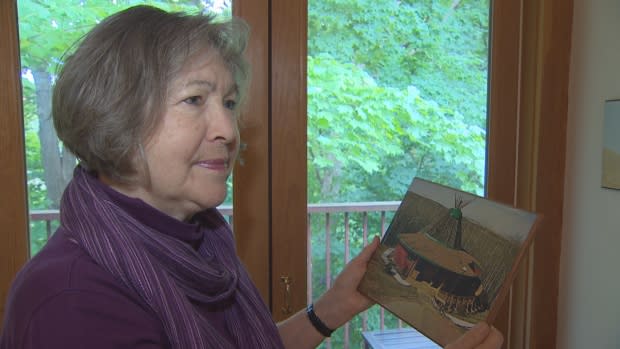What life is like inside the Okimaw Ohci Healing Lodge housing child killer Terri-Lynne McClintic
Nestled among the rolling hills of southwestern Saskatchewan, several wooden cabins surrounded by autumn barren trees make up what is known as the Okimaw Ohci Healing Lodge.
It may sound like a wilderness retreat, but this is a federal penitentiary.
It's operated by the Corrections Canada to house incarcerated women, including 28-year-old Terri-Lynne McClintic — the convicted killer of eight-year-old Tori Stafford, whose death and disappearance captured national attention after police scoured the southwestern Ontario countryside for months in one of the largest-ever searches for a missing person in Canada.
McClintic's transfer from an Ontario medium-security prison to Okimaw Ohci not even halfway through her life sentence has sparked national outrage, but advocates for the healing lodge are defending its effectiveness to rehabilitate offenders.
"To put people behind bars is really kind of revengeful," said Mary Sanderson, a former art therapist who volunteered at Okimaw Ohci between 2007 and 2012.
"The healing lodge believes that there is something that can be drawn out of those women, who mainly have been abused and come from lives of terrible violence."
Critics are furious.
"It boggles the mind," said John Muise, a former member of the Parole Board of Canada and a volunteer director for Abuse Hurts, an organization working to stop child exploitation. "I've been to a healing lodge in Alberta, it's a very comfortable place in comparison to a typical maximum or medium security institution.
"Are there no other offenders that could benefit from one of these few beds that exist for healing and reintegration?"
What is the Okimaw Ohchi Healing Lodge
The Okimaw Ohci Healing Lodge is located on the Nekaneet First Nation about 30 kilometres southeast from the closest city of Maple Creek, Sask.
Members of the Nekaneet First Nation have expressed anger that a child-killer is living on their territory and they had no say in the matter.
It opened in 1995 and is the oldest of nine Indigenous healing lodges across the country introduced in an attempt to address high rates of Indigenous incarceration.
Okimaw Ohci has minimum to medium security operations. The inmates are not behind bars. In fact, they're not even called inmates. They're known as residents of the lodge.
The purpose of the lodge is to address the underlying issues that have brought the women here so they can make a successful transition back into the community.

For example, Sanderson worked to help lodge inmates express themselves using pastels, paint and clay.
Sometimes, she said she would draw the outline of a man and ask the women to throw clay at it.
"It allowed them to begin to deal with the strong, repressed emotions," Sanderson said.
"One of the great things that happened in the groups was as they heard about what somebody else had done, maybe the same crime as them, they began to think, well, maybe there's hope for me."
Who is there
Inmates in other facilities have three ways of getting into Okimaw Ohci. They can apply for relocation, Corrections Canada can suggest a residency, or sometimes inmates are placed at the lodge once they've completed their sentence.
There are currently 50 women staying at the 60-bed facility and there are 89 staff members, according to Corrections Canada. There are guards, but they almost never carry guns.
It costs approximately $167,000 to house an offender at Okimaw Ohci. The average cost of maintaining a woman offender annually at a traditional prison is $191,843, according to the correctional service.
Okimaw Ohci was the most expensive healing lodge operated by the correctional service last year costing $8,907,589. That is less than a traditional prison. In comparison, the price for the Grand Valley Institution for Women in Kitchener, Ont., where McClintic used to serve, last year was $27,857,804.
Okimaw Ohci is one of two healing lodges for women nationwide.
Another one called Buffalo Sage is located in Edmonton. It has a minimum to medium security risk level, but it's operated by the Native Counseling Services of Alberta and is much smaller with 16 beds.
Residents at Okimaw Ohci are mostly Indigenous, but non-Indigenous people can attend as long as they agree to Indigenous programming and spirituality.
What they do
Upon arrival, inmates have to go through an X-ray machine, ion scanner and are subject to a strip search, according to the corrections service.
A brief tour is provided by staff and a member of the residents' peer support group.
Health care providers will meet with the new offender within the first 24 hours. They're given new identification and a phone card.

A typical day involves four inmate counts starting at 6:45 a.m. Residents receive breakfast, lunch and dinner. They're expected to attend a program, work or remain in their rooms. They are allowed to participate in recreation, cultural events or a self-help group in the evening before lights go out at 11 p.m.
The women have their own rooms with a bathroom, kitchenette, eating area and living room, which they are responsible for keeping tidy.
They also have to work in the kitchen, shovel snow and look after the gardens.
Programming includes education and horse therapy
At the centre of the facility is a main lodge and spiritual centre which is treated as a sacred place where ceremonies are held inside by a fire.
A personal life plan is created for each resident outlining what she needs emotionally, physically and spiritually to help with her rehabilitation.
The residents can participate in a variety of moderate to high-intensity programs, including cultural identity, job training, parenting skills, peer mentorship, self-help and hobby crafts.

The women are given the opportunity to learn basic literacy and work toward their high school diploma.
They can also work on therapy by taking care of horses that live on the property.
"They began to learn responsibility and accountability — something that many of them had never known before," Sanderson said.
"So it allowed them to grow and change, and surely it's what we want for all inmates. It's simply giving them another opportunity. A chance."
Opponents are quick to point out that the effectiveness of the healing lodge's rehabilitation programs is still unclear. And they say the facilities are a bit too plush for criminals, particularly child killers.
"Do we really know that grooming and tending to horses … results in a positive outcome to public safety?" said Muise, the former parole officer. "When money is stretched so thin, it's not good enough to do feel-good stuff."
Security
There are no fences or even a barbed wire preventing anyone from leaving but there are guards.
Offenders are briefed upon their arrival on where they are allowed to go and which areas are out of bounds. They are not allowed to leave the premises without prior authorization.
There hasn't been an escape at Okimaw Ohci in the past decade, according to the Corrections Canada.

"The healing lodge actually most resembles what the regional prisons were supposed to look like," said Senator Kim Pate, who visited the lodge in her former role as executive director of the Canadian Association of Elizabeth Fry Societies.
"The benefits for an individual are that they are able to continue to work beyond the programs that are available in other prisons, and to take responsibility and be held accountable in more stringent ways."
A lack of community involvement
Chief Alvin Francis of Nekaneet First Nation said he didn't know McClintic was being relocated to Okimaw Ohci until it was reported in the news and he isn't happy about it. His community doesn't have input on who gets transferred.
Community concerns will be addressed in an upcoming review of Okimaw Ohci that's expected to be released in a few weeks along with a re-examination of the decision and policies that led to McClintic's transfer, according to Public Safety Minister Ralph Goodale.
McClintic is not eligible for parole until 2031.

